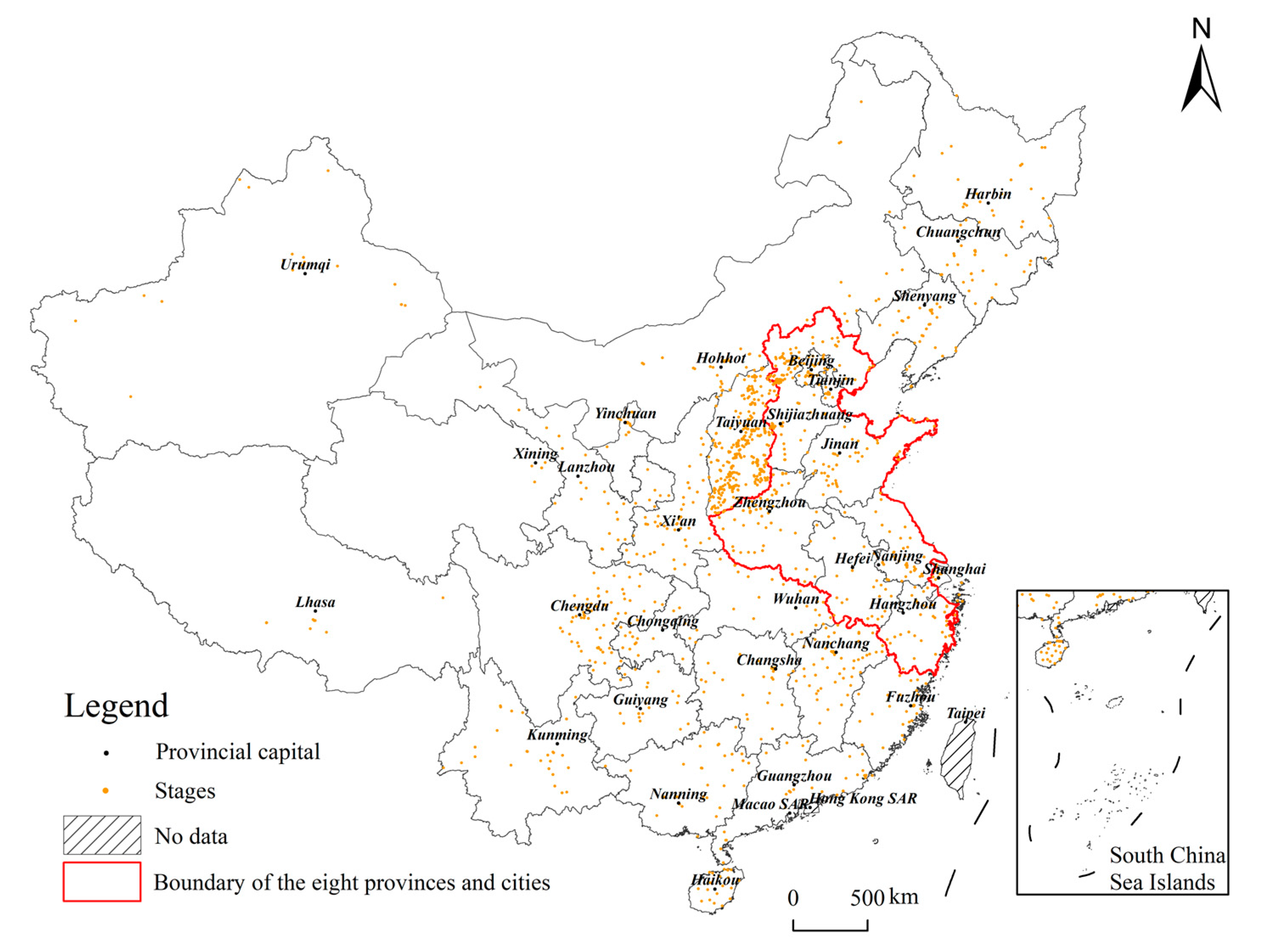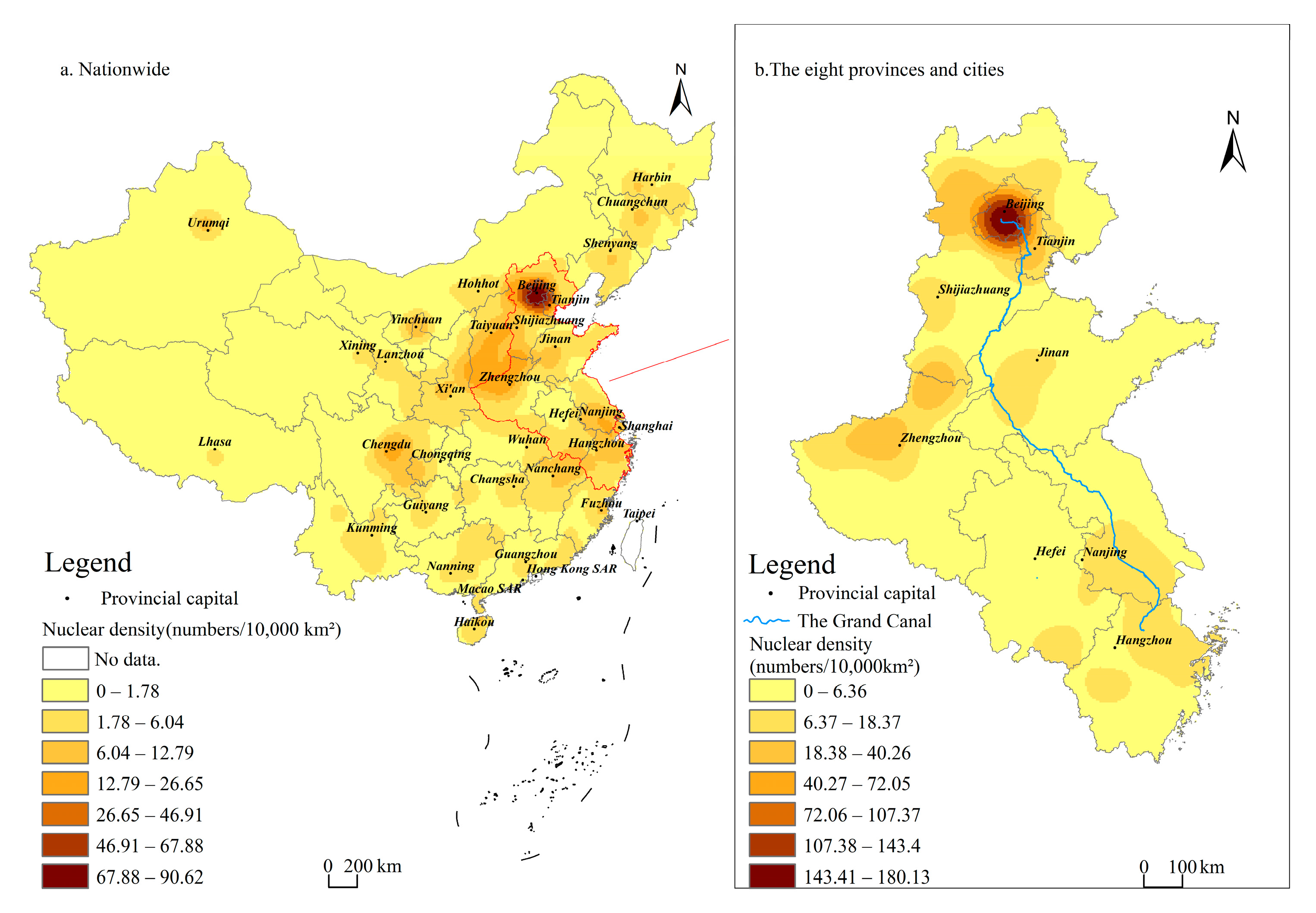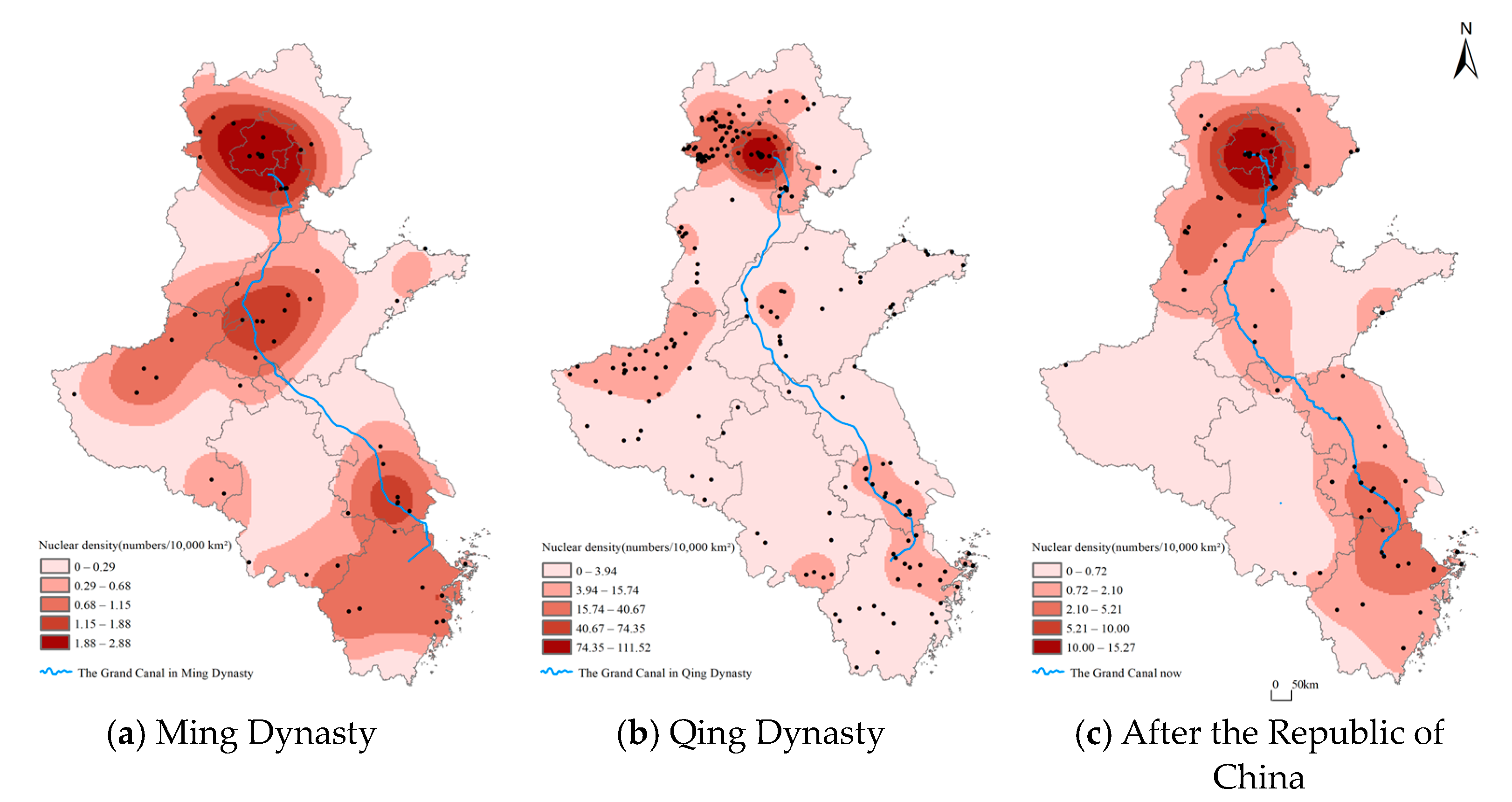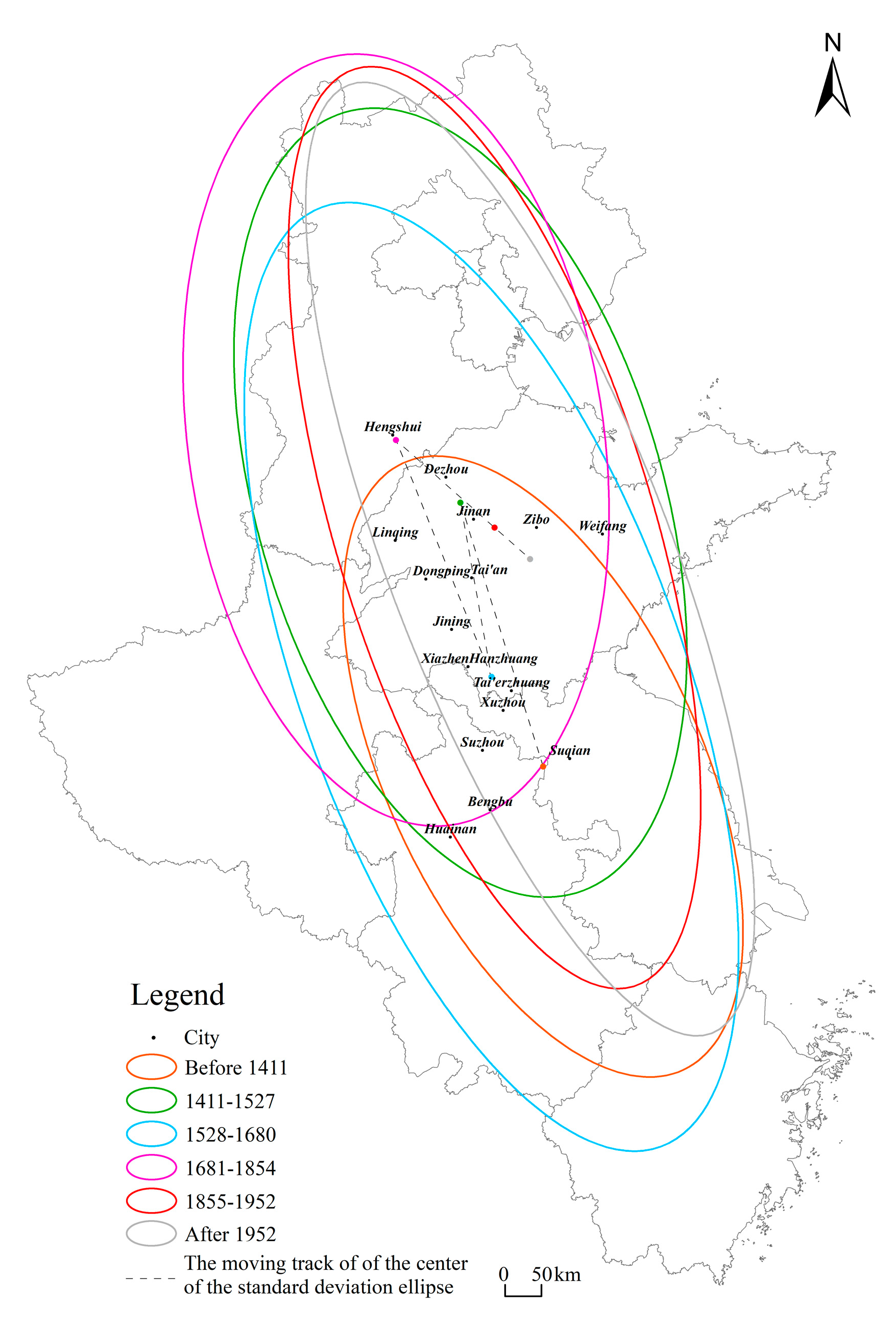Analysis of Spatial and Temporal Distribution Patterns of Traditional Opera Culture along the Beijing–Hangzhou Grand Canal
Abstract
:1. Introduction
2. Data and Methods
2.1. Data
2.1.1. Data Sources
2.1.2. Data Collection and Processing
2.2. Analysis Method
2.2.1. Kernel Density Analysis
2.2.2. Standard Deviational Ellipse Analysis
3. Results
3.1. Spatial Distribution
3.1.1. Density Analysis
3.1.2. Centroid and Direction Analysis
3.2. Temporal Variation
3.2.1. Density Variation Analysis
3.2.2. Analysis of Centroid and Direction Changes
4. Conclusions and Discussion
4.1. Conclusions
- (i)
- The spatial distribution of traditional opera culture has clear characteristics of clustering. The opera stages are mainly distributed in patches. They are represented by one primary core area, two secondary core areas, and five tertiary core areas within the eight provinces and cities along the Grand Canal and by four major clusters at the national level.
- (ii)
- From a temporal perspective, the changes in the number and locations of opera stages are closely related to the rise and fall of the Grand Canal. The analysis between different dynasties showed that during the Ming Dynasty, opera stages were distributed along the beginning, middle, and end sections of the Grand Canal; in the Qing Dynasty, as the Grand Canal thrived and developed, the number of opera stages gradually increased, ultimately forming a dense concentration of opera stages in a band-like cluster along both sides of the Grand Canal; and after the establishment of the Republic of China and later the founding of the People’s Republic of China, the number of opera stages gradually declined, but they remained distributed in a band-like cluster along the Grand Canal. Overall, traditional opera culture originated along the Grand Canal, gradually prospered with the development of the Grand Canal, and eventually became concentrated in a band-like cluster along the Grand Canal.
- (iii)
- From the Ming Dynasty to the founding of the People’s Republic of China, the spread of traditional opera culture in the eight provinces and cities along the Grand Canal followed a “southeast–northwest” trajectory, with opera stages mainly located in the “Zhangjiakou-Hangzhou” area, aligning with the main direction of the Grand Canal, and driven by it as well. In terms of the distribution centroid, since the Ming Dynasty, the centroid of traditional opera culture in the eight provinces and cities has been located in the central and western parts of Shandong Province on the eastern bank of the Grand Canal and in proximity to the waterway. At the national level, the center shifted to the western bank of the Grand Canal, approximately parallel to the Grand Canal’s waterway, spanning from the central part of Henan to the southeastern part of Shanxi, with its spatial pattern driven by the Grand Canal. Regarding the distribution direction, the spread in the north–south direction covered a broader area than in the east–west direction and the spatial distribution pattern of traditional opera culture had a close relationship with the north–south spatial characteristics of the Grand Canal.
- (iv)
- On the centennial scale, the evolution characteristics of the distribution centroid of traditional opera culture in the eight provinces and cities along the Grand Canal from before the 14th century to the 20th century are closely related to the key time nodes of the construction of the Grand Canal and the expansion of its basin. Since the Ming Dynasty, the direction of the movement of the centroid of traditional opera has shown a trend of shifting between the northern and southern regions, following the flow direction of the Grand Canal. Overall, the direction of the spread of traditional opera culture changed in accordance with the direction of the construction of the Grand Canal.
4.2. Discussion
Author Contributions
Funding
Data Availability Statement
Acknowledgments
Conflicts of Interest
References
- Zhou, A. Born and prospered by the river: The relationship between the iteration of Chinese traditional operas in Yuan, Ming and Qing Dynasties and the Beijing-Hangzhou Grand Canal. Qilu Realm Arts 2022, 1, 71–77. [Google Scholar]
- Zhao, Y. On Operas in Song Dynasty and the Grand Canal. Cult. Stud. 2017, 4, 360–374. [Google Scholar]
- Miao, J. The Beijing-Hangzhou Grand Canal and the spread of Ming and Qing opera. Cent. Plains Cult. Res. 2015, 3, 70–76. [Google Scholar]
- Liu, Q.; Xu, K.; Yang, X. Geographical Mechanisms of Regional Differentiation and Evolution of Pronunciation and Singing Tune Under the New Mobility Paradigm—A Case Study of Ten Local Operas in China. In Proceedings of the 4th International Conference on Humanities Education and Social Sciences (ICHESS 2021), Xishuangbanna, China, 29–31 October 2021. [Google Scholar]
- Fu, Y. The analysis of Chinese Drama in Anhui Province in geography culture way. In Proceedings of the 4th International Conference on Applied Social Science (ICASS 2014), Singapore, 20–21 March 2014. [Google Scholar]
- Zhang, X. Differentiation and Integration of Cultural Regions: A Study of Shaanxi History, Geography and Culture; Shanghai Bookstore Press: Shanghai, China, 2004. [Google Scholar]
- Li, Y. The Spatial Distribution of Genres of Shandong Local Operas. J. Xi’an Conserv. Music 2020, 39, 53–63. [Google Scholar]
- Zhang, X.; Xiang, H.; Liu, R. Spatial pattern and influencing factors of intangible cultural heritage of music in Xiangxi, central China. Herit. Sci. 2022, 10, 39. [Google Scholar] [CrossRef]
- Fu, X.; Zhang, J. The distribution characteristics and construction reasons of Pingyang temp stage in Shanxi during the Ming and Qing dynasties. J. Xinzhou Norm. Univ. 2015, 31, 64–114. [Google Scholar]
- Chai, G. An explanation of distributional characteristics of ancient stages in Shanxi in space vision. J. Southeast Univ. (Philos. Soc. Sci.) 2010, 12, 99–128. [Google Scholar]
- Wang, X.; Zou, Z. Open Data Based Urban For-Profit Music Venues Spatial Layout Pattern Discovery. Sustainability 2021, 13, 6226. [Google Scholar] [CrossRef]
- Wu, K. The spatial diffusion of opera culture and the evolution of cultural region: Taking Huai Opera, the intangible cultural heritage as a case study. Geogr. Res. 2009, 28, 1427–1438. [Google Scholar]
- Tian, Y.; Chen, M.; Liu, Y. Spatiotemporal patterns and influencing factors of intangible cultural heritage of music in the “Yellow River—Yangtze River Civilization Corridor”, China. arXiv 2023. [Google Scholar] [CrossRef]
- Fang, J. The formation and the diffusion of Qin Opera culture from the perspective of cultural geography. Hum. Geogr. 2013, 28, 64–69. [Google Scholar]
- Sun, Y. Jingji Province Operas Spatial Distribution and Its Transmission. J. Baoding Univ. 2014, 27, 87–92. [Google Scholar]
- Xia, Y.; Huang, C. Evolution of cultural area of Huangmei opera. J. Anhui Norm. Univ. (Hum. Soc. Sci.) 2006, 34, 726–729. [Google Scholar]
- Florida, R.; Mellander, C.; Stolarick, K. Music Scenes to Music Clusters: The Economic Geography of Music in the US, 1970–2000. Environ. Plan. A Econ. Space 2010, 42, 785–804. [Google Scholar] [CrossRef]
- Borowiecki, K.J. Geographic clustering and productivity: An instrumental variable approach for classical composers. J. Urban Econ. 2013, 73, 94–110. [Google Scholar] [CrossRef]
- Aspden, S. Operatic Geographies: The Place of Opera and the Opera House; University of Chicago Press: Chicago, IL, USA, 2019. [Google Scholar]
- Craig, C.S. Creating cultural products: Cities, context and technology. City Cult. Soc. 2013, 4, 195–202. [Google Scholar] [CrossRef]
- Krims, A. Music and Urban Geography; Routledge: New York, NY, USA, 2007. [Google Scholar]
- Gao, R. Shanxi Ancient Stage Digital Display Design; Taiyuan University of Technology: Taiyuan, China, 2022. [Google Scholar]
- Duan, Y. The Research on the Spatial Distribution and Historical Changes of Han Opera’s Performance Venues in Wuhan; Hubei University: Wuhan, China, 2018. [Google Scholar]
- Emanuel, P. On Estimation of a Probability Density Function and Mode. Ann. Math. Stat. 1962, 33, 1065–1076. [Google Scholar]
- Lefever, W.D. Measuring Geographic Concentration by Means of the Standard Deviational Ellipse. Am. J. Sociol. 1926, 32, 88–94. [Google Scholar] [CrossRef]






| Data Sources | Number of Stages |
|---|---|
| The Chronicles of Chinese Traditional Opera Cultural Relics: Volume of Opera Stages | 1562 |
| The Chronicles of Chinese Traditional Opera | 657 |
| Region and Period | Ming Dynasty | Qing Dynasty | After the Founding of the Republic of China and then the People’s Republic of China |
|---|---|---|---|
| Eight provinces and cities | (35.53° N, 117.37° E) | (37.00° N, 116.42° E) | (36.35° N, 117.73° E) |
| Nationwide | (34.28° N, 113.89° E) | (34.98° N, 113.10° E) | (36.38° N, 113.02° E) |
| Region and Period | Ming Dynasty | Qing Dynasty | After the Founding of the Republic of China and then the People’s Republic of China |
|---|---|---|---|
| Eight provinces and cities | 156.18 | 160.26 | 156.86 |
| Nationwide | 156.85 | 25.76 | 49.82 |
| Region and Period | Ming Dynasty | Qing Dynasty | After the Founding of the Republic of China and then the People’s Republic of China | |||
|---|---|---|---|---|---|---|
| Minor Semi-Axis | Major Semi-Axis | Minor Semi-Axis | Major Semi-Axis | Minor Semi-Axis | Major Semi-Axis | |
| Eight provinces and cities | 245.22 | 684.27 | 281.82 | 616.23 | 174.41 | 686.95 |
| Nationwide | 615.73 | 758.02 | 630.58 | 909.29 | 1205.36 | 1352.11 |
| Time | Centroid Coordinates | Size (km2) | Azimuth (°) | Flattening Ratio | Minor Semi-Axis (km) | Major Semi-Axis (km) |
|---|---|---|---|---|---|---|
| Before 1411 | (33.63° N, 118.09° E) | 313,636.50 | 155.18 | 0.5293 | 216.78 | 460.57 |
| 1411–1527 | (36.92° N, 116.86° E) | 493,494.50 | 163.45 | 0.5008 | 280.04 | 560.98 |
| 1528–1680 | (34.76° N, 117.33° E) | 571,415.13 | 160.19 | 0.6159 | 264.33 | 688.20 |
| 1681–1854 | (37.69° N, 115.85° E) | 482,322.03 | 171.73 | 0.4653 | 286.54 | 535.84 |
| 1855–1952 | (36.61° N, 117.38° E) | 454,672.09 | 163.09 | 0.6683 | 219.12 | 660.61 |
| After 1952 | (36.22° N, 117.93° E) | 428,236.20 | 159.02 | 0.7215 | 194.86 | 699.71 |
Disclaimer/Publisher’s Note: The statements, opinions and data contained in all publications are solely those of the individual author(s) and contributor(s) and not of MDPI and/or the editor(s). MDPI and/or the editor(s) disclaim responsibility for any injury to people or property resulting from any ideas, methods, instructions or products referred to in the content. |
© 2023 by the authors. Licensee MDPI, Basel, Switzerland. This article is an open access article distributed under the terms and conditions of the Creative Commons Attribution (CC BY) license (https://creativecommons.org/licenses/by/4.0/).
Share and Cite
Yang, J.; Hu, D.; Chen, Z.; Xu, Y.; Zou, Z.; Zhu, Y. Analysis of Spatial and Temporal Distribution Patterns of Traditional Opera Culture along the Beijing–Hangzhou Grand Canal. ISPRS Int. J. Geo-Inf. 2023, 12, 477. https://doi.org/10.3390/ijgi12120477
Yang J, Hu D, Chen Z, Xu Y, Zou Z, Zhu Y. Analysis of Spatial and Temporal Distribution Patterns of Traditional Opera Culture along the Beijing–Hangzhou Grand Canal. ISPRS International Journal of Geo-Information. 2023; 12(12):477. https://doi.org/10.3390/ijgi12120477
Chicago/Turabian StyleYang, Jiayi, Di Hu, Zihan Chen, Yicheng Xu, Zewei Zou, and Ying Zhu. 2023. "Analysis of Spatial and Temporal Distribution Patterns of Traditional Opera Culture along the Beijing–Hangzhou Grand Canal" ISPRS International Journal of Geo-Information 12, no. 12: 477. https://doi.org/10.3390/ijgi12120477






